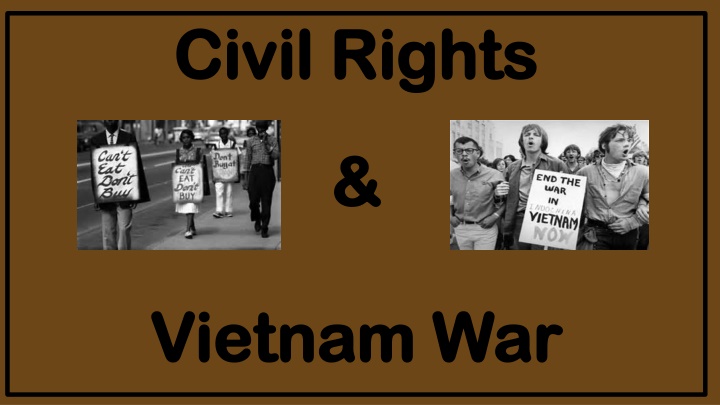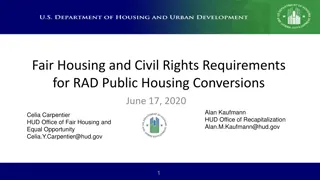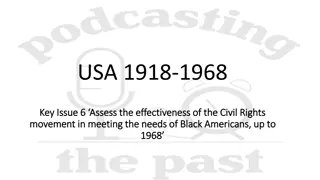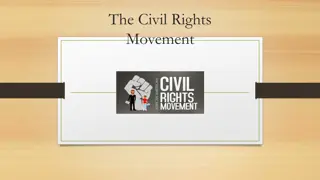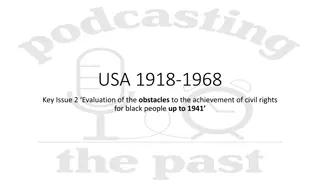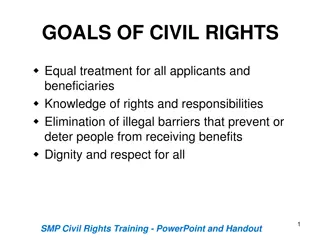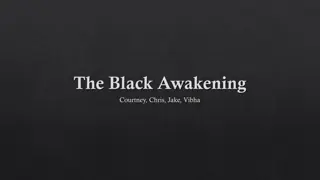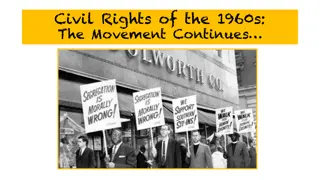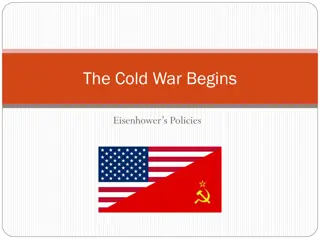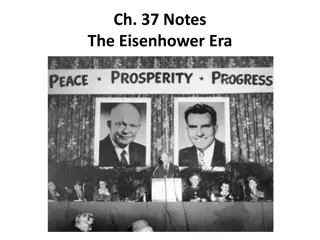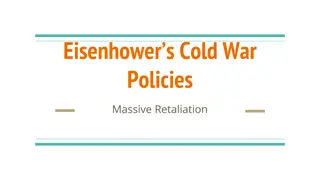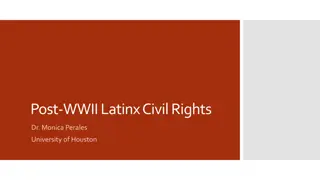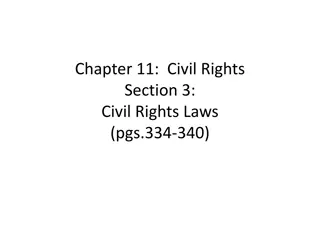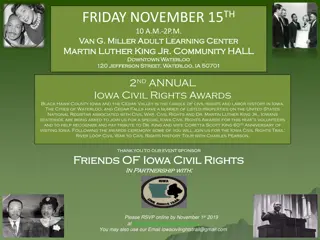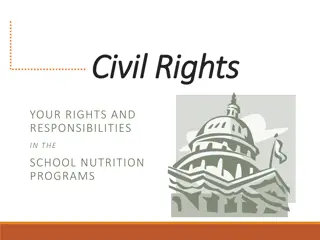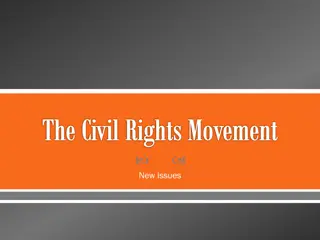The Impact of Civil Rights Movement and President Eisenhower's Legacy
Explore the significant events like the Civil Rights Movement, the popular presidency of Dwight D. Eisenhower, the Federal Aid Highway Act of 1956, the Baby Boom Years, and the advent of television in the lives of Americans during the mid-20th century. Learn about civil rights, segregation, the Brown vs. Board of Education case, and the transformation brought by the television medium.
Download Presentation

Please find below an Image/Link to download the presentation.
The content on the website is provided AS IS for your information and personal use only. It may not be sold, licensed, or shared on other websites without obtaining consent from the author.If you encounter any issues during the download, it is possible that the publisher has removed the file from their server.
You are allowed to download the files provided on this website for personal or commercial use, subject to the condition that they are used lawfully. All files are the property of their respective owners.
The content on the website is provided AS IS for your information and personal use only. It may not be sold, licensed, or shared on other websites without obtaining consent from the author.
E N D
Presentation Transcript
Civil Rights Civil Rights & & Vietnam War Vietnam War
President Dwight D. Eisenhower President Dwight D. Eisenhower 1. What made President Eisenhower so popular? - he was a war hero and people liked his warm personality; helped to end WW2 and Korean War
2. What was the Federal Aid Highway Act of 1956? -made transportation system better as far as roads; allowed people to get around better and military supplies and soldiers to travel easier in case of emergency.
Baby Boom Years Baby Boom Years 3. What is a veteran? -a person who has served in the military; they were eager to buy houses settle down, and start families
4. Explain the term baby boom. - the increase in the number of babies born after World War II during the 1950s; population grew so fast that builders could hardly keep up with the increased demand for homes; built large housing developments
5. How did the television change the lives of Americans? -it changed the way people learned about the world around them; before TV was radio and newspaper
Civil Rights Movement Civil Rights Movement 6. What are Civil Rights? -the rights that countries guarantee their citizens Examples: right to vote, right to equal treatment, and right to speak out
7. What was segregation? - separated by racial or ethnic groups; in some cities blacks could not use the same restaurants and schools as whites 8. Explain the famous court case of Brown vs. the Board of Education of Topeka, Kansas. -case challenged the law of separate but equal ; people argued that segregated schools did not get the same education as white students; Thurgood Marshal (first African American to server on Supreme Court) brought the case to Supreme Court and won
9. What ruling did the Supreme Court make about schools in 1954? - all public schools be desegregated
10. What was the Montgomery Bus Boycott? What was its goal? -in 1955, an African American woman, Rosa Parks, refused to give up her seat on a crowded bus and was arrested; her church organized a boycott and stopped using public transportation for a year; its goal was to challenge a segregation law in Montgomery, Alabama; eventually Supreme Court made segregation on buses illegal; Dr. Martin Luther King Jr. led boycott
11. In what way was Dr. Martin Luther King Jr important to the civil rights movement? -he was a great leader who promoted a strategy of nonviolent protest ( a way of bringing change without using violence) 12. What was a sit in? -a form of protest in which African Americans sat down at a whites only restaurant or store and refused to leave until they were served.
13. Explain the purpose of the 1963 March on Washington for jobs and Freedom. - to show support for the bill to end segregation in the United States; was held in Washington D.C; was where Dr. Martin Luther King Jr. gave his famous I Have a Dream Speech 14. Who was Cesar Chavez? - Mexican American activist who wanted to improve conditions for migrant farm workers in California
15. Describe NOW. - National Organization of Women fought for Women s rights and worked hard to pass the ERA. 16. Describe the Equal Rights Amendment. -would have guaranteed rights for women but did not pass ; was part of the women s movement
17. What did the Civil Rights Act of 1964 do? - banned segregation in schools, workplaces, and public places 18. Explain some of the accomplishments of John Fitzgerald Kennedy. -President of the United States during Cold War, Cuban Missile Crises, created Peace Corps (sent volunteers to teach children, grow food, and help start businesses in countries around the world); was President during Space Race; encouraged Americans to serve their country
19. Who were some of the leaders assassinated during the 1960s? A. John F. Kennedy- shot while in a motorcade while in Dallas, Texas; many people thought he was giving too many rights and was killed because he gave people ideas and energy to change B. Robert Kennedy- shot and killed while campaigning to be elected president in California;
C. Dr. Martin Luther King Jr. assassinated in Memphis on a motel balcony
21. Who became president after President John F. Kennedy was assassinated? -Vice President Lyndon Johnson asked Americans to work for a society that demands an end to poverty and racial injustice ; started government program called Great Society (programs that provided food, shelter, medical care, education, and job training to people who couldn t pay for them); also known as Welfare
The Space Race The Space Race 22. What was the Space Race? - a competition between the U.S.A and the Soviet Union to send people to outer space; Soviet Union won with Sputnik I going into space first; John Glenn was the first American to orbit Earth in capsule called Friendship 7.
23. What is NASA? -National Aeronautic and Space Administration; responsible for sending objects on space missions in outer space
Popular Culture in the 1960s Popular Culture in the 1960s 24. What happened when the baby boom generation became teenagers? -Many wanted to end injustice and poverty; they wanted to change American culture and politics 25. What kind of music and art were popular in the 1960s? - Rock n roll music; pop art
Vietnam War Vietnam War 26. Remember, what did the United States try to do during the Cold War? - stop the spread of communism 27. Who were the Vietcong? -communist fighters who went into South Vietnam
28. Why did U.S leaders decide to send soldiers to Vietnam? -the U.S sent soldiers to help prevent communists from overthrowing the South Vietnamese government 29. What did the Vietcong do to fight against the technology of the U.S military? - they fought in small groups and hid in the jungle
30. Why did opposition to the war grow in the United States as the fighting continued? -the cost in dollars and in lives kept growing 31. How did people show their opposition to the Vietnam War? -they took part in antiwar demonstrations and marches 32. What were some effects of the war on the United States? -thousands of Americans died; U.S was not able to stop communism in Vietnam
33. Who was president of the United States at beginning of the Vietnam War? - President Lyndon B. Johnson; President Richard Nixon became president towards the end of the war and pulled troops back to the U.S 34. What was the cease-fire during the Vietnam War? - an agreement to stop all fighting; U.S soldiers in Vietnam went home; once U.S soldiers went home, communists began attacking again: Two years later, North Vietnam defeated South Vietnam; war lasted 8 years
